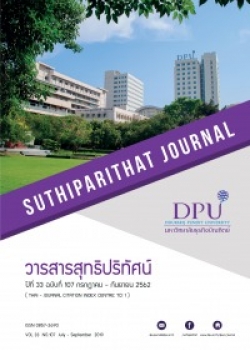ความสัมพันธ์ระหว่างส่วนชดเชยทรัพยากรกับผลการดำเนินงานของบริษัทจดทะเบียนในตลาดหลักทรัพย์แห่งประเทศไทย
คำสำคัญ:
ส่วนชดเชยทรัพยากร, ผลการดำเนินงานบทคัดย่อ
ส่วนชดเชยทรัพยากรเป็นสิ่งสำคัญที่องค์กรใช้ในการปรับตัวทางการวางแผนและควบคุมนโยบายรวมถึงการกำหนดกลยุทธ์ที่สำคัญเพื่อนำพาองค์กรให้ประสบความสำเร็จและเพิ่มมูลค่าให้กับผลการดำเนินงาน งานวิจัยครั้งนี้จึงมีวัตถุประสงค์เพื่อศึกษาความสัมพันธ์ระหว่างส่วนชดเชยทรัพยากรกับผลการดำเนินงานของบริษัทจดทะเบียนในตลาดหลักทรัพย์แห่งประเทศไทย ประชากรในการศึกษาครั้งนี้คือ ผู้บริหารระดับสูงและรายงานประจำปีของสถานประกอบการ โดยใช้แบบสอบถามและกระดาษทำการเป็นเครื่องมือในการเก็บข้อมูลตัวอย่างจากองค์กร โดยการวิเคราะห์ข้อมูลองค์ประกอบ 3 วิธี ประกอบด้วย การวิเคราะห์องค์ประกอบเชิงสำรวจ การวิเคราะห์องค์ประกอบเชิงยืนยันและการทดสอบสมมติฐานโมเดลสมการโครงสร้าง ผลการวิจัยพบว่า ส่วนชดเชยทางองค์กรมีความสัมพันธ์ทางบวกกับการดำเนินงานของบริษัทจดทะเบียน โดยมีความสัมพันธ์ในทิศทางเดียวกันกับผลการดำเนินงานสำหรับส่วนชดเชยทางการเงินมีความสัมพันธ์ทางบวกกับการดำเนินงานของบริษัท โดยมีความสัมพันธ์ในทิศทางเดียวกันกับผลการดำเนินงานและส่วนชดเชยทรัพยากรขององค์กรมีความสัมพันธ์ทางบวกกับการดำเนินงานของบริษัทจดทะเบียน โดยมีความสัมพันธ์ในทิศทางเดียวกันกับผลการดำเนินงานเช่นกัน นอกจากนี้ ยังพบว่ารูปแบบความสัมพันธ์ระหว่างส่วนชดเชยทรัพยากรขององค์กรกับผลการดำเนินงานที่ดีที่สุด คือความสัมพันธ์ทางอ้อมของส่วนชดเชยทรัพยากรขององค์กร ซึ่งหมายถึงการบริหารจัดการส่วนชดเชยทางองค์กรที่มีประสิทธิภาพจะทำให้ส่วนชดเชยทางการเงินมีประสิทธิภาพที่เพิ่มสูงขึ้นเช่นกัน นำมาสู่ผลการดำเนินงานมีประสิทธิภาพที่ดีที่สุด
เอกสารอ้างอิง
ชลลดา เลิฟ, และพัทธนันท์ เพชรเชิดชู. (2562). ผลการดำเนินงานด้านสิ่งแวดล้อม สังคม และบรรษัทภิบาลกับคุณภาพกำไร. วารสารสุทธิปริทัศน์, 33(106), 179-194.
พุทธิสุทธ์ ตรีรัตน์ดิลกกุล, และพัทธนันท์ เพชรเชิดชู. (2562). โครงสร้างเงินทุน นโยบายการจ่ายเงินปันผลและคุณภาพกำไรของบริษัทจดทะเบียนในตลาดหลักทรัพย์แห่งประเทศไทย. วารสารสุทธิปริทัศน์, 33(106), 70-91.
Artie, N., & Wai, M. W. (2018). Slack resources and quality performance: case of a mega health care organization. International Journal of Quality & Reliability Management, 35(5), 1060-1074.
Astley, W. G. (1978). Sources of power in organizational life (Unpublished doctoral dissertation), University of Washington.
Bourgeois, L. J. (1981). On the measurement of organizational slack. Journal Academy of Management Review, 6(1), 29-39.
Cyert, R. M., & March, J. G. (1963). A behavioral theory of the firm. Englewood Cliffs, N. J.: Prentice-Hall.
Dan, M., & Geiger, S.W. (2015). The organizational slack and performance relationship: a configurational approach. Management Decision, 53(10), 2339-2355.
Daniel, F., Lohrke, F. T., Fornaciari, C. J., Turner, R. A. (2004). Slack resources and firm performance: A meta-analysis. Journal of Business Research, 57(6), 565-574.
Fonseka, M. M., Peng, W., & Muhammad, S. M. (2013). Impact of human resource slacks on firm performance: Evidence from a developing country. Zbornik Radova Ekonomskog Fakultet au Rijeci, 31(2), 279-306.
Galbraith, J. (1973). Designing complex organizations. Reading, Mass.: Addison-Wesley.
Geroski P., Machin, S., & Reenen, J. V. (1993). The RAND. Journal of Economics, 24(2), 198-211.
Hambrick, D. C., & Snow, C. C. (1977). A contextual model of strategic decision making in organizations. Academy of Management Proceedings, 1.
Hughes, M., Eggers, F., Kraus, S., & Hughes, P. (2015). The relevance of slack resource availability and networking effectiveness for entrepreneurial orientation. International Journal of Entrepreneurship and Small Business, 6(1), 116-138.
James, D., & Thompson, S. (1967). Organizations in actions social science bases of administrative theory. New York: Routledge.
Jensen, M.C. (1986). Agency costs of free cash flow, corporate finance, and takeovers. The American Economic Review, 76(2), 323-329.
Joseph, L. C., & Idalene, F. K. (1997). Organizational slack and response to environmental shifts: The impact of resource allocation patterns. Journal of Management, 23(1), 1-18.
Lorenzo, B. (2017). The strategic role of financial slack on alliance formation. Management Decision, 55(2), 383-399.
Sanghoon, L. (2012). Corporate governance, financial slack and firm performance: A comparative study between US and UKSeoul. Journal of Business, 18(1), 1-12.
Scott, W. G., Marlin D., & Sharon L. S. (2019). Slack and performance in the hospital industry: A configurational approach. Management Decision, Vol. ahead-of-print No. ahead-of-print. https://doi.org/10.1108/MD-07-2017-0703.
Xing, L., & Zhanming, J. (2018). Effects of unexpected financial slack on SMEs’ diversification and growth: evidence from China. Nankai Business Review International, 9(4), 500-518.
ดาวน์โหลด
เผยแพร่แล้ว
รูปแบบการอ้างอิง
ฉบับ
ประเภทบทความ
สัญญาอนุญาต
เนื้อหาและข้อมูลในบทความที่ลงตีพิมพ์ในวารสารสุทธิปริทัศน์ ถือเป็นข้อคิดเห็นและความรับผิดชอบของผู้เขียนบทความโดยตรงซึ่งกองบรรณาธิการวารสาร ไม่จำเป็นต้องเห็นด้วย หรือร่วมรับผิดชอบใด ๆ
บทความ ข้อมูล เนื้อหา รูปภาพ ฯลฯ ที่ได้รับการตีพิมพ์ในวารสารสุทธิปริทัศน์ ถือเป็นลิขสิทธิ์ของวารสารสุทธิปริทัศน์หากบุคคลหรือหน่วยงานใดต้องการนำทั้งหมดหรือส่วนหนึ่งส่วนใดไปเผยแพร่ต่อหรือเพื่อกระทำการใด ๆ จะต้องได้รับอนุญาตเป็นลายลักษณ์อักษรจากวารสารสุทธิปริทัศน์ก่อนเท่านั้น







